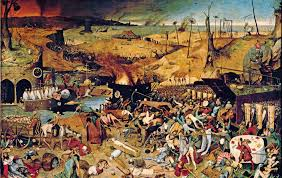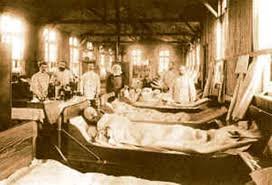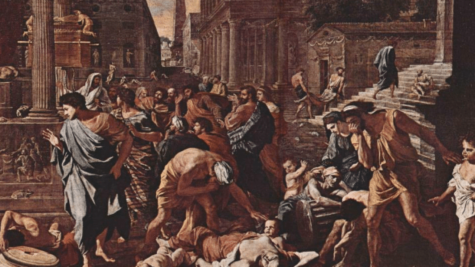Past Pandemics: A Review

In 1346-1353, the Black Death was one of the most dangerous diseases.
February 3, 2021
It’s hard to imagine what a pandemic would look like in the early 17th, 18th, 19th century or even earlier. Today, we have a lot of knowledge about viruses, diseases, illnesses, vaccines and more. But in those early centuries? The flu vaccine only came out in 1930. Many people who lived in the 17th and 18th century probably didn’t even know much about diseases and viruses. In this article, you will see some of the deadliest and most life changing pandemics of the past. You can find out more about them, like how they started, how they ended, what caused them, and many more facts!
The Black Death
Even though the Black Death is almost harmless now, thanks to antibiotics and modern medicine, in 1346-1353, the Black Death was one of the most dangerous diseases. There were about 60.8 million cases of the Black Death, and 75-200 million people died from it. The Black Death originally came from Asia where living conditions were not that good, and were in close contact with black rats, which carried Yersinia Pestis which caused the Black Death. It was then transferred by fleas and trading ships to many continents, such as Europe, Africa, Egypt, Persia, Syria, and India. Symptoms of the Black Death include fevers, chills, vomiting, aches and pains and diarrhea. The Black Death ended after people started quarantining, and would only leave their houses when it was necessary, such as visiting the doctor, grocery shopping, etc. Compared to COVID-19, this pandemic seems much worse. The death toll of COVID is way less, even though the symptoms are pretty much the same. Even though the Black Death was one of the worst pandemics our planet has experienced, the Black Death has changed a lot of people’s lives – positively. The Black Death killed many people, but provided better living standards and waged for the workers and peasants who survived. This gave them more power over their lives and better lives.
HIV/AIDS
The first case reported of Human Immunodeficiency Virus/Acquired Immunodeficiency Syndrome, otherwise known as HIV/AIDS was in 1981. Since then, it evolved into a global pandemic, with an estimated amount of 65 million infections and 25 million deaths. It mostly affected Sub-Saharan Africa, South Asia, Southeast Asia, Middle East Africa and North Africa. This viral infection is transmitted by blood contact, and can last several years or lifelong. If left untreated, it could be dangerous or life threatening. The symptoms usually are fever, headache, muscle aches, joint pain, rash, sore throat, swollen lymph glands, etc. There currently is no vaccine or cure for HIV/AIDS. Compared with COVID, the symptoms are almost the same, but the way it spreads is different. To keep safe from this virus, make sure you don’t have blood contact with anyone, just in case if they have HIV or AIDS. Also, the viatical settlement industry became popular during the AIDS pandemic, which could be considered it’s silver lining.
Antonine Plague
The Antonine Plague, or the Plague of Galen was of 165 to 180 AD, mainly occurring in ancient Rome. It was brought to the Roman Empire by some troops who were returning from campaigns in the Near East. Galen, a Greek physician witnessed the outbreak, and described its symptoms. The most common symptoms were fever, diarrhea, vomiting, thirstiness, swollen throat, and coughing. Galen also noted that the diarrhea appeared blackish, which could have been gastrointestinal bleeding, and the coughing produced a foul odor. The epidemic probably came from China spreading along the Silk Road and ending up in Rome. It is said that up to 3000 ancient Romans dropped dead every single day, and the death toll was 5 million. The cause of the pandemic is unknown, and it is also unknown how the plague ended, but historian William H. McNeill states that the Antonine Plague and later the Plague of Cyprian were outbreaks of two diseases, smallpox and measles, but not necessarily in that order. Since the cause and end is still unknown to this day, there is no cure and no vaccine. Compared to COVID, it’s death toll is less, and the symptoms are about the same. Because this pandemic was about two thousand years ago, you don’t have to worry about getting the Antonine Plague. If the Antonine Plague was actually smallpox, then we would all be safe, due to the fact that smallpox has been completely eradicated.

The Flu Pandemic in 1918 (Spanish Flu)
Out of the three flu pandemics that have happened, the Flu Pandemic in 1918, also known as the Spanish Flu, has been the most dangerous. With 500 million cases, and 50 million deaths worldwide, this is a virus that now has a vaccination, but did not in 1918. Symptoms of the Spanish Flu are fever, nausea, aches, and diarrhea. Even though the Spanish Flu is called the Spanish Flu, it didn’t originate from Spain. Scientists are still unsure where it has started, but China, France, and Britain have all been possible birthplaces of the virus. The first case in the United States was in Kansas, on March 11, 1918. This deadly pandemic all started, because of a simple cause. In the last months of World War I, soldiers lived in wet, dirty and cramped conditions, and soon got sick. The Spanish Flu hasn’t really come to an end, as the flu still exists to this day, but there is a vaccine for it now. Compared to COVID-19, the flu is really similar to COVID scientifically speaking. However, the Spanish Flu has a lot more deaths than COVID, and the symptoms are similar.
Third Cholera
There have been a total of seven major cholera pandemics in history. The third one was thought to be the deadliest out of all of them. It’s said that the origins of the Third Cholera outbreak were in the Ganges River of India. It’s also likely that the first and second Cholera outbreaks also originated there. The Third Cholera Pandemic has an estimate of over 1 million deaths. During this pandemic, physician John Snow had a theory, called the “miasma theory” which stated that “disease transmission was spread through bad or noxious air.” Snow then proved that theory by plotting all of the infected residents’ houses on a map, which eventually led to a public water pump on Broad Street. So, what exactly is Cholera? Cholera is a bacterial disease which spreads through contaminated food and water. It’s usual symptoms are uncontrollable amounts of liquid diarrhea that lasted for several days. Some other synonyms are a bluish tint due to dehydration, cold skin, and wrinkling of hands and feet. Today, we have treatment and a vaccine. To prevent cholera, make sure you have good hygiene, sanitation, and clean food and water. You may have been told or heard that Cholera is a deadly disease, but Cholera has taught many people how to stay safe and healthy. Cholera has also inspired many people to fight for clean water and better living conditions for poor countries.

The Plague of Justinian
Another deadly, yet historical pandemic. The Plague of Justinian claimed between 30-50 million lives. This pandemic all started from rats, carrying infected fleas around. They brought the disease to Constintinaple, the capital of the Roman Empire back in 330 AD to 1453, where 5,000 people died everyday. The Plague of Justinian happened during the years 541-542. Although this disease is no longer around, symptoms of this disease are like the usual, fevers, headaches, chills, gangrene, abdominal pain, swollen or tender lymph nodes, etc.
This pandemic ended mostly by quarantining, and staying at home. This pandemic is very much like the COVID pandemic, the one we are facing now, because both pandemics started from animals. For the Plague of Justinian, they also quarantined. Although this may seem like a very dark pandemic, this has helped scientists and doctors learn more about medicine, and evolve in medicine. Without pandemics like these, modern medicine wouldn’t be the same.

The first thing you might think when you hear the word pandemic is probably something negative. Even though these pandemics did cause a lot of deaths, they also brought something positive along. Every single pandemic in history has taught scientists and doctors more and more about medicine. Many pandemics, like the Black Death and Plague of Justinian, have created better living standards for people, and better hygiene. So the next time you think about pandemics, don’t just think about negative things. Think about the positive things! Even during COVID, a lot of positive things have happened. We now have a vaccine, and got to spend more time with our families, or maybe even did something we really wanted to. Pandemics aren’t just about death and viruses, they are about getting through hard times together. Now that you’ve learned a bit more about past pandemics, do you feel a bit better about COVID?
Sources:
“10 Of the Deadliest Global Pandemics of All Time.” HistoryCollection.com, 1 Feb. 2018, historycollection.com/10-deadliest-global-pandemics/4/.
“1918 Pandemic (H1N1 Virus).” Centers for Disease Control and Prevention, Centers for Disease Control and Prevention, 20 Mar. 2019, www.cdc.gov/flu/pandemic-resources/1918-pandemic-h1n1.html.
Andrews, Evan. “Why Was It Called the ‘Spanish Flu?’.” History.com, A&E Television Networks, 12 Jan. 2016, www.history.com/news/why-was-it-called-the-spanish-flu.
History.com Editors. “Black Death.” History.com, A&E Television Networks, 17 Sept. 2010, www.history.com/topics/middle-ages/black-death.
History.com Editors. “Spanish Flu.” History.com, A&E Television Networks, 12 Oct. 2010, www.history.com/topics/world-war-i/1918-flu-pandemic.
Horgan, John. “Antonine Plague.” Ancient History Encyclopedia, Ancient History Encyclopedia, 9 Jan. 2021, www.ancient.eu/Antonine_Plague/.
“Outbreak: 10 of the Worst Pandemics in History.” Outbreak: 10 of the Worst Pandemics in History, 2020, www.mphonline.org/worst-pandemics-in-history/.
Pruitt, Sarah. “Microbe Behind Black Death Also Caused Devastating Plague 800 Years Earlier.” History.com, A&E Television Networks, 31 Aug. 2016, www.history.com/news/microbe-behind-black-death-also-caused-devastating-plague-800-years-earlier.







